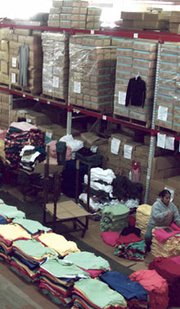More Opportunities, More Competition for Off-Pricers in '09
American consumers once demanded luxury, but in the past year, they’ve increasingly demanded a deal. This sort of market should be tailor-made for off-price retailers such as Ross Stores Inc. of Pleasanton, Calif. But the weak economy has been creating busts as well as booms for off-pricers.
Since last year, retail and consumer interest has been growing for off-price goods, which includes branded fashion sold for 20 percent to 70 percent below department-store prices. The market’s leading trade event, the Off-Price Specialist Show, forecasts an 18.9 percent increase in buyer attendance for its upcoming Feb. 15–18 show at the Venetian Grand Ballrooms in Las Vegas.
A spike in consumer interest and a glut of new product have turned the last few months into a busy season for many off-price dealers. In contrast to companies laying off workers, executives of CA Off Price, a Montebello, Calif.–based off-price dealer, on Jan. 12 began encouraging their more than 30 workers to work overtime.
It’s the job of these workers to inspect and repackage the newly arrived off-price merchandise. The new product ranges from designer jeans to generic tops. The merchandise comes into the off-pricer’s possession after retailers cancel orders from manufacturers, or it comes from liquidated companies, such as defunct retailer Mervyns, which went out of business in November.
For liquidators such as Jacques Stambouli, owner of Lynwood, Calif.–based Via Trading Corp., recessionary times mean good business. “The supply of goods has never been so abundant,” he said.
Even before the economy declined in late 2008, the off-price market was growing. Unit sales for American off-price retailers increased 10 percent between November 2007 and November 2008, according to market researchers The NPD Group Inc.’s Consumer Tracking Service. During the same period, department stores’ unit sales decreased 9.6 percent, and national specialty chains decreased 2.4 percent, according to NPD.
Still, few retailers are completely immune from the ravages of the weak economy. In January, leading off-price retailers Ross Stores Inc. and The TJX Companies Inc. both reported declining same-store sales of 2 percent and 4 percent, respectively.
Unprecedented promotions and sales from frontline retailers such as Macy’s also may be giving off-pricers what may be its first heavy competition, according to Ken Wengrod, president and founder of financial institution FTC Commercial Corp. “Frontline stores are doing their own off-price sales now. They have new merchandise for better prices. Why would consumers go to an off-price store?” Wengrod asked.
Still, some off-price retailers were bullish enough to open more stores in the past year. Ross opened 26 stores during its third quarter of 2008, which was reported Sept. 10. The TJX Companies Inc. opened 20 Marshall’s stores during its third quarter, reported Nov. 11, and 13 TJ Maxx stores.
Entry into the retail side of the business was easy for novice independent off-price boutique owner Edward Goldbaum. He debuted his All Pro Basics Sporting Goods in March 2008 in Burbank, Calif. He sells off-price men’s sportswear with price points ranging from $8 for men’s tank tops to $65 for a silk baseball jacket with the Los Angeles Dodgers logo. He estimated his prices are 25 percent to 50 percent lower than department stores’. He picked up his merchandise at the Off-Price Specialist Show. Vendors gave a green light to doing business with Goldbaum after he showed them his business license and resale license and proved he had a solid line of credit.
Getting into the wholesale—or “jobbing”—side of the off-price game has become a lot tougher. Gone are the days when a businessperson could easily peddle his or her way into becoming an independent jobber dealing in off-price merchandise. The Off-Price Specialist Show was created in 1995 to make a chaotic, sometimes rough-hewn field, into a professional market for businesspeople, said David Lapidos, group vice president of the trade show. “It’s difficult to be a jobber. Once, all you needed to buy goods was a bank account,” he said. “Now you need bankers and a place to warehouse merchandise [to handle volume orders].”
Leading off-pricers such as Bermo Enterprises of Schoolcraft, Mich., tend to be well-established companies running sophisticated enterprises. Bermo, for example, maintains a 160,000-square-foot warehouse and offers services such as its wholesale catalog posted online, bar-coded inventory for its retail clients, and packing and holding merchandise for clients.
Still, there are opportunities in the off-price market for retailers of all sizes. Via Trading sells much of its off-price goods to small retailers and independent eBay-style shops through its business-to-business e-commerce Web site (www.viatrading.com). Stambouli claims 100,000 people visit his B2B off-price site each month. He forecasts continued growth for his online presence, but he also maintains a bricks-and-mortar warehouse near the Los Angeles International Airport, where retailers can purchase goods. “You can’t do anything now without doing it online,” Stambouli said. “But some of our customers do not have Internet access. So, you have to offer as many [business] channels as possible.”
The off-price consumer increasingly demands high-quality merchandise, said David L. Sacks, a retail consultant and founder of the Sacks SFO Inc. off-price retail chain. “Even if you’re selling nice goods, big-box [off-pricers] won’t buy them unless they are convinced it’s a brand,” Sacks said.
No matter what economic future lies in wait for the fashion industry, there will always be a need for jobbers, said Doron Kadosh, president of CA Off Price. “Manufacturers need us to help them get rid of their over-production or excess inventory,” he said. “Or they’ll run the risk of putting their business in a financial straightjacket.”























